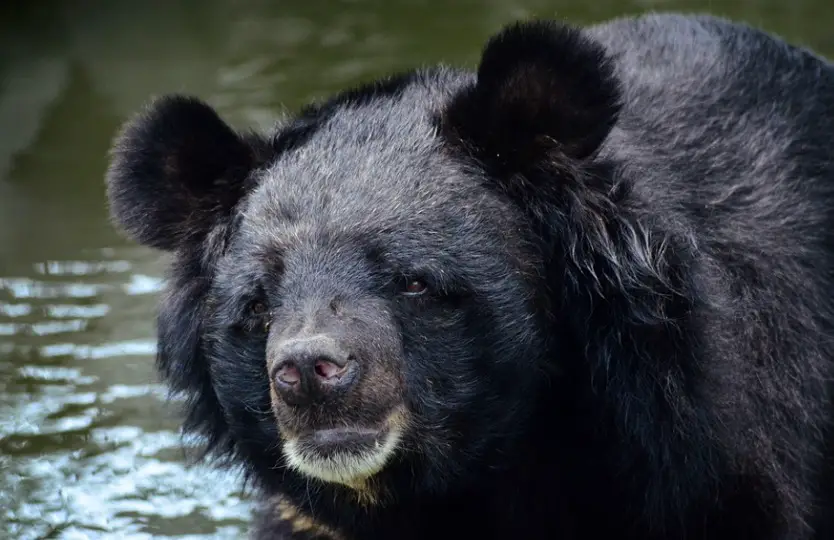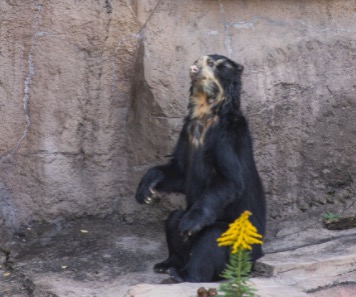Table of Contents
Moon Bear: All You Need To Know
A moon bear is an omnivorous scavenger that belongs to the kingdom of Animalia, phylum Chordata, and class Mammalia. Its genus is Ursus, and its species is Ursus thibetanus. Its length is up to 0.7 to 1.0 m, and it weighs about 40 to 200 kg. It lives in deciduous forests, grasslands, and wetlands, with a lifespan of about 25 years.

What is Moon Bear?
Moon bears, also known as Asian Black Bears or White-chested Bears, are a herbivorous species that dwells in deciduous forests, meadows, and marshes at elevations of approximately 11,000 feet across Asia. This bear looks a lot like its cousin, the American Black Bear, but it’s a little more agile and has a unique white patch on its breast.
Asian moon bears, like American black bears, eat anything from insect larvae to plants, mushrooms, and human trash. The moon bear is a mostly lonely species that prefers to scavenge on its own. However, groups of moms and their cubs can occasionally be spotted.

Unfortunately, this causes a lot of friction between moon bears and people. Every year, a number of individuals are assaulted and mauled by moon bears. According to some naturalists, the moon bear is more violent than its American relative.
They believe the moon bear must be more aggressive to live since it shares territory with tigers. This frequently results in moon bear assaults on people and subsequent moon bear revenge killings. Moon bears also have weak vision, which might make them more easily frightened and attacked.
Moon bears are in high demand among consumers due to their purported therapeutic qualities in Traditional Chinese Medicine. The desire for moon bear parts motivates a continuous attempt to hunt these fragile creatures, despite the fact that none of these alleged characteristics have been proven by contemporary research. Other concerns, including land conversion for agriculture, dams, habitat damage, and a shrinking population, are putting the moon bear in jeopardy.

Fun Facts About Moon Bear!
The moon bear, like many of the species we examine, exhibits some very intriguing biological principles that are crucial to comprehend. The most significant of them are conservation behaviour, wild animal markets, and human-wildlife relationships!
Moon Bear: Conservation Behavior
Conservation Behavior is a relatively young discipline of zoology that focuses on researching animal behaviour in order to help in animal conservation. The moon bear is a great illustration of why this is so essential. Human encroachment and poaching are two of the most serious dangers to moon bears. Many other big creatures, unsurprisingly, experience similar harassment.
Conservation behaviour attempts to investigate conflict-inducing habits, such as the moon bear’s urge to scavenge through human waste and crops, and transform these into chances to protect the bears.
Conservation behaviourists, for example, could try to persuade farmers to grow a “protective” crop around their farms that keeps bears away. Other methods of deterring moon bears include making loud sounds, using strong repellent odours, or using other methods that are natural to moon bear behaviour.
Wild Animal Markets
Moon bears are highly demand for in a variety of nations for a variety of reasons. Moon bear bile is thought to have therapeutic powers, while moon bear paws are prized and revered as holy. Moon bear babies are also sought after as pets and carnival attractions since they are easily trainable in the appropriate environment.
On the one hand, many small populations throughout Asia are fed and supported by wild animal marketplaces. The demand for rare items and live animals, on the other hand, rises in tandem with the population. Consumption of wild animals eventually results in the degradation of wild habitats and the extinction of creatures, as humanity has seen many times before.
While a complicated solution to wild animal markets will be required to meet the requirements of local people, it will also be necessary to safeguard mankind from possible zoonotic illnesses spread by these markets, as well as wild animals from over-exploitation and extinction.
Human-Wildlife Interactions
The moon bear, like many other big creatures in the Carnivora group, is frequently hunted for attacking people. While it is unfortunate that humans are assaulted, this is a wild animal that ought to be respected and given room.
Bad human-wildlife encounters usually result in a negative public perception of a specific species. Even if the animal has caused far less harm to humans than some of our own innovations, such as aircraft, this is true. When cattle or humans are assaulted by a wild animal, public opinion swiftly shifts.
For example, at Yellowstone National Park, the US has attempted to restore wolves and other predators. Local farmers, who are attempting to safeguard their animals, have fought back hard against this initiative.
While research suggests that wolves would avoid cattle as long as they have access to a natural food source, ranchers are understandably concerned about their livelihood. This makes conservation measures difficult to execute in some regions, which will most likely be the case for the moon bear as well.
Moon Bear Citations
- Ebola success, Moon bears and gene-therapy delay. Nature . 2019 Aug;572(7769):288-289.
- Cretinism in a North American black bear (Ursus americanus). Vet Radiol Ultrasound . Jan-Feb 2002;43(1):31-6.
- Himalayan black bear mauling: offense or defense? Am J Otolaryngol . Jul-Aug 2007;28(4):247-50.







